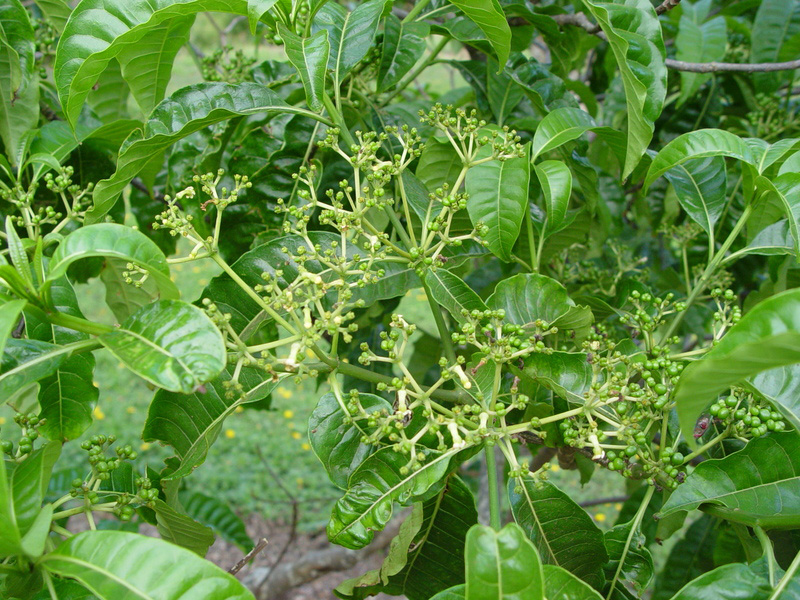Tropical Plant Database - Plant Details
Rauvolfia vomitoria
Click on any heading above to view more information about this plant
Conservation Status
- IUCN: least concern
- USFWS: None
Family: APOCYNACEAE
Genus: Rauvolfia
Species: vomitoria
Species Author: Afzel.
Synonyms: Rauvolfia pleiosiadica
Genus: Rauvolfia
Species: vomitoria
Species Author: Afzel.
Synonyms: Rauvolfia pleiosiadica
Rauvolfia vomitoria is a shrub or small tree up to 8 m tall. The leaves grow in whorls of three and are elliptic and pointed at the end, 5-12 cm long and 3-6 cm wide. Flowers are tiny, sweet-scented, pale greenish-white, and somewhat hairy inside. The orange fruits are shaped like small balls, each containing a single seed.
(http://www.efloras.org/florataxon.aspx?flora_id=2&taxon_id=200018460 (Flora of China Website))
(http://www.efloras.org/florataxon.aspx?flora_id=2&taxon_id=200018460 (Flora of China Website))
Certain species of Rauvolfia are a source of medicinal alkaloids, especially reserpine. This species is commercially grown in parts of Asia for this purpose. In Africa this tree is used in many countries in many different ways. In Gabon, for example, the bark and root powder are mixed with water or palm oil to kill fleas and other insects. Rauvolfia vomitoria is used by Nigerian traditional healers to treat psychiatric patients. In the Democratic Republic of Congo R. vomitoria is used to treat leprosy The bark can be used as an emetic and purgative (to induce vomiting).
(PROSEA world agroforestry database http://www.worldagroforestrycentre.org/sea/Products/AFDbases/AF/asp/SpeciesInfo.asp?SpID=1768)
(PROSEA world agroforestry database http://www.worldagroforestrycentre.org/sea/Products/AFDbases/AF/asp/SpeciesInfo.asp?SpID=1768)
As you can tell by the species name, eating this plant is probably not a good idea as it may induce vomiting. Many species of Rauvolfia contain toxic alkaloid and other compounds.
A yellow dye is obtained from the bark. The seeds are used in making decorative necklaces.
(PROSEA world agroforestry database http://www.worldagroforestrycentre.org/sea/Products/AFDbases/AF/asp/SpeciesInfo.asp?SpID=1768)
(PROSEA world agroforestry database http://www.worldagroforestrycentre.org/sea/Products/AFDbases/AF/asp/SpeciesInfo.asp?SpID=1768)
This tree is native to tropical Africa
(http://www.ars-grin.gov/cgi-bin/npgs/html/taxon.pl?30897)
(http://www.ars-grin.gov/cgi-bin/npgs/html/taxon.pl?30897)
This tree has become extremely invasive on the Big Island of Hawaii (North Kohala District) and should not be planted because of its known potential to become weedy. The small orange fruits could be easily spread by birds. The National Tropical Botanical Garden has eliminated this species from its living collections.
The tree is a wild host of the pathogen causing ‘collar crack’ of cacao, but nevertheless it is still used as a shade tree for young cacao trees and as a support for vanilla in Gabon.
(PROSEA world agroforestry database http://www.worldagroforestrycentre.org/sea/Products/AFDbases/AF/asp/SpeciesInfo.asp?SpID=1768)
The tree is a wild host of the pathogen causing ‘collar crack’ of cacao, but nevertheless it is still used as a shade tree for young cacao trees and as a support for vanilla in Gabon.
(PROSEA world agroforestry database http://www.worldagroforestrycentre.org/sea/Products/AFDbases/AF/asp/SpeciesInfo.asp?SpID=1768)
The generic name Rauvolfia, is named after a 16th century German physician, Leonhart Rauvolf, who traveled the world over collecting and documenting medicinal plants. The specific epithet vomitoria refers to the purgative and emetic properties of the bark. In Ivory Coast, the ‘Serpent Sect’ of the Man region consider the plant a fetish. The young twigs with the side branches trimmed short serve as mixers for drinks, hence the English name swizzle stick.
(PROSEA world agroforestry database http://www.worldagroforestrycentre.org/sea/Products/AFDbases/AF/asp/SpeciesInfo.asp?SpID=1768)
(PROSEA world agroforestry database http://www.worldagroforestrycentre.org/sea/Products/AFDbases/AF/asp/SpeciesInfo.asp?SpID=1768)
- 040838 - collected by David H. Lorence in 2002
- 047538 - collected by Melora Purell in 2008
- 055229 - collected by David H. Lorence in 2009
- S062658 - collected by David H. Lorence in 2009
- 063940 - collected by Oahu Early Detection in 2009
We currently have 5 herbarium specimens for Rauvolfia vomitoria in our collection. Click on any specimen below to view the herbarium sheet data.
.svg)





















